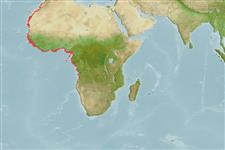Classificação / Names
Common names from other countries
Referência principal
Tamanho / Peso / Idade
Max length : 30.0 cm TL macho/indeterminado; (Ref. 57395); common length : 23.0 cm TL macho/indeterminado; (Ref. 3660)
Length at first maturity
Lm 14.8 range ? - ? cm
Ambiente
; marinhas; estuarina bentopelágico; intervalo de profundidade 10 - 100 m (Ref. 57395), usually 15 - 80 m (Ref. 26999)
Clima / Intervalo
Tropical, preferred 25°C (Ref. 107945); 35°N - 16°S, 19°W - 14°E (Ref. 54289)
Distribuição
Descrição breve
Espinhos dorsais (total): 10 - 13; Raios dorsais moles (total): 11-14; Espinhos anais 3; Raios anais moles: 9 - 10. Diagnosis: body oblong and compressed; dorsal profile slightly and regularly convex; snout shorter than eye diameter (Ref. 57395). Mouth large, oblique (Ref. 5377, 57395) and protrusible (Ref. 57395). Lower jaw slightly prominent; 2 anterior pores on chin, followed by a median pit bearing openings of two large pores (Ref. 57395). Eyes large (Ref. 5377). Dorsal fin deeply notched; caudal fin deeply forked; scales ctenoid on body and head (Ref. 57395).
Coloration: back olivaceous, sides silvery to white; dark spot at angle of opercle; sometimes several small, dark spots on dorsal-fin base (Ref. 57395). Fins grey (Ref. 5377).
Categoria na Lista Vermelha da IUCN (Ref. 115185)
Ameaça para o homem
Harmless
Utilização humana
Pescarias: altamente comercial
Mais informação
ReferênciasAquaculturaPerfil para aquaculturaEstirpesGenéticaFrequência dos alelosHereditariedadeDoençasProcessamentoMass conversion
ColaboradoresFotografiasStamps, CoinsSonsCiguateraVelocidadeTipo de nataçãoÁrea branquialOutras referênciasCérebrosVisão
Ferramentas
Relatórios especiais
Descarregue XML
Fontes da internet
Estimates of some properties based on models
Phylogenetic diversity index
PD50 = 1.0000 many relatives (e.g. carps) 0.5 - 2.0 few relatives (e.g. lungfishes)
Nível Trófico
3.0 ±0.44 se; Based on food items.
Resiliência
Médio, tempo mínimo de duplicação da população 1,4 - 4,4 anos (K=0.29-0.4; tmax=7;)
Vulnerabilidade
Low to moderate vulnerability (33 of 100)
Categoria de preço
